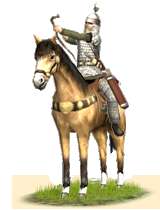Asavârân-î Dêhbêd (Parthian Noble Medium Cavalry)
 |
Weapons | Defence | Mental | ||||||
|---|---|---|---|---|---|---|---|---|---|
| Primary | Secondary | Armour: | 9 | Morale: | 13 | ||||
| Type: | none | spear | Shield: | 0 | Discipline: | disciplined | |||
| Attack: | 5 | 4 | Skill: | 9 | Training: | trained | |||
| Charge: | 34 | 34 | Recruitment | Other | |||||
| Lethality: | 1 | 0.4 | Soldiers: | 25 | Hit Points: | 1 | |||
| Range: | 187 | 0 | Cost: | 2667 | Mass: | 1 | |||
| Ammo: | 40 | 0 | Upkeep: | 667 | |||||
| Turns: | 1 | ||||||||

These minor Parthian nobles are excellent medium cavalry, with both scale armour for protection and bow to provide real versatility against any enemy.
Superior
Disciplined
Hardy
Can Form Cantabrian Circle
The Dehbeds are noble armoured cavalry, using the Kontos in a two-handed grip and able to charge home if needed. They rely on the composite horse bow kept in a Gorytos on the left side to weaken their enemy before closing for melee. They can afford a better class of equipment than typical horse archers, including a scale corselet split at the sides that hangs to the rider’s waist when he is in the saddle. They also carry lances, and are not afraid to close in for melee if the opportunity presents itself, but are sensible enough not to hurl themselves into the fray against unbroken infantry. The Dehbeds are much cheaper to raise and maintain than Cataphracts or Asavaran and form the majority of shock cavalry. The Dehbed cavalry is a very flexible force, being extremely mobile and able both to provide concentrated archery or when required to charge, fully able to drive home an attack.
Historically, the Dehbeds were the lesser nobility and village chieftains not yet having risen to their more prominent role under the Sassanids, men who led their Bandaka retainers to war. These units of the lesser aristocracy were composed of men of well above average station. The Dehbeds were members of the Azat nobility of Parthia. Descendents of the lords of smaller clans and the chieftains of tribal times, they formed the warbands of the great feudal lords (azat). They were a class of noble warriors, their vassalage to the Parthian King expressed in their duty and their privilege of serving in the feudal cavalry. They would evolve into the Dihqans of Sassanid times.